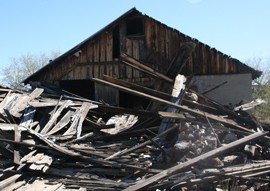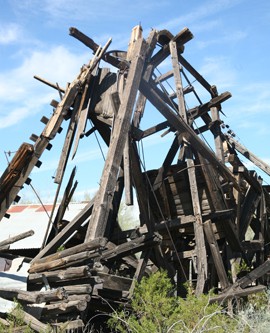- Slug: BC-CNS-Vulture Mine,800
- Sidebar: Facts about mine.
- Photos available (thumbnails, captions below)
- Multimedia: YouTube video
By GRISELDA NEVAREZ
Cronkite News Service
WICKENBURG – Dave Rodgers often journeys from his home in Surprise to explore remnants of the Vulture Mine: a tree where those who stole gold were hung, machinery that crushed ore to remove gold and even clothes and shoes that miners wore.
Taking self-guided tours, he and others can examine stone walls of what was the home of Henry Wickenburg, who discovered gold here in 1863, towering wood rigging used to lift ore from the shaft and other relics from an operation that yielded $200 million worth of gold before closing in 1942.
“Everything is just there like it was the day they shut down the mine,” Rodgers said. “They just left their stuff and walked off.”
Up to 5,000 people once lived in Vulture City, the community that sprang up around the mine. Stories of spirits roaming the ghost town continue to draw visitors.
But years of weathering and neglect have taken a toll. The 11 buildings that still stand, including two schoolhouses and the assay office, have crumbling walls of stone and adobe. Wood roofs and walls are in even worse shape, and nails and pieces of metal pose hazards for visitors.
Marty Hagan, a Wickenburg resident volunteering here on a recent weekday, said preserving this site would not only safeguard an irreplaceable piece of Arizona’s gold-mining past but also benefit the community.
“We have a legacy in our own backyard and they don’t realize that,” he said. “If the mine was publicized more and it became a better tourist attraction, we could bring even more people into town.”
The nonprofit Vulture Mine Preservation and Restoration Association, of which Hagan is vice president, launched in 2009 to protect the history that survives here. The group would like to restore the buildings, offer guided tours, showcase artifacts and add shops and restaurants.
But it may not get the chance.
The owners of the 274 acres that include the mine and its surroundings want to sell. But the association can’t afford the $3.5 million asking price, which has dropped from more than $6 million over the past few years.
Members of the group have tried unsuccessfully to assemble enough donations and grants to purchase the property. Now they’re hoping that a buyer steps forward to help them.
“We want someone that’s willing to work with us to save it so that we don’t lose its history,” he said.
The Vulture Mine could have qualified for money from the Heritage Fund, which draws on lottery proceeds to fund grants administered by Arizona State Parks. But the $10 million grant money was swept to help balance the state budget.
James Garrison, state historic preservation officer for Arizona State Parks, said the Vulture Mine is worth preserving.
“The mine itself has simply played an important part in the development of Arizona,” he said.
In the late 1800s, the Vulture Mine was one of the biggest attractions for pioneers who came to Arizona. The U.S. government used its gold to help finance the Civil War and later used it to help finance the Salt River Project.
Garrison is working with the Wickenburg Historical Preservation Society to add the mine to the National Register of Historic Places. That would, among other things, make possible federal preservation grants, though the current federal budget has frozen those funds.
Adding the Vulture Mine to the register also would make it eligible for grants from the Save America’s Treasures and Preserve America, two national groups that work to uphold properties of national significance.
Cindy Thrasher, president of the Wickenburg Historical Preservation Society, said the remaining artifacts reveal history that can’t be found anywhere else in Arizona.
“You’ll go to Old Tucson or other places in the West that have tried to fabricate something like that, and here we have the real thing and we take it for granted or we’re not concerned about it,” she said.
Marshall Trimble, Arizona’s state historian, said he envisions the Vulture Mine becoming something like Goldfield Ghost Town, an attraction near Apache Junction that allows visitors to see how miners lived in the Old West.
“You hear it in stories or see it in movies, but you can experience it yourself at these places,” he said.
While the fate of the property remains uncertain, Hagan’s group is moving to save the ghost town’s two schoolhouses, which are federal land, through an agreement with the U.S. Bureau of Land Management.
Hagan said he hopes the Vulture Mine’s historic significance will motivate others to help save it.
“This is one of the mines that really was the major attraction to bring people to Arizona, and to let our history just die like that, it’s nonsense,” he said.
^___=
Vulture Mine facts:
– $200 million in gold was taken from the mine.
– Gold from the mine was used to finance the Civil War and the Salt River Project.
– Vulture City is one of the largest ghost towns in the U.S. It once had a population of 5,000.
– Structures in Vulture City were built using ore from the mine.
– The site is open to the public daily from 9 a.m. to 3 p.m.
^___=

The Vulture Mine has had virtually no efforts to preserve it, resulting in widespread decay. Those seeking to preserve the mine say that this was one of the main things that drew people to Arizona originally and should be preserved. (Cronkite News Service Photo by Griselda Nevarez)

Martin Hagen is vice president of the Vulture Mine Preservation and Restoration Association. (Cronkite News Service Photo by Griselda Nevarez)

This tree, said to be used for hanging those who stole from the mine, is located in the front yard of Wickenburg’s home. (Cronkite News Service Photo by Griselda Nevarez)

The Vulture Mine’s main shaft. (Cronkite News Service Photo by Griselda Nevarez)